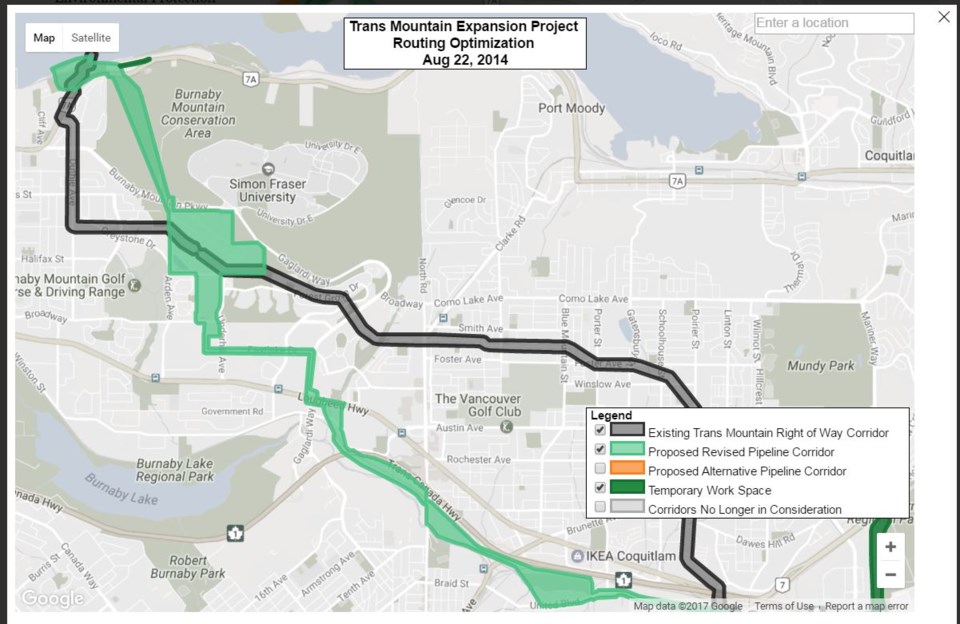Burnaby landowners whose property will be crossed by the Trans Mountain expansion project should expect some mail this Friday.
It’s all part of the next step in the routing process.
On Feb. 10, the National Energy Board (NEB) approved Trans Mountain’s draft of its Plan, Profile and Book of Reference (PPBoR). The PPBoR requires Trans Mountain to submit aerial maps of the pipeline, land types, the names of the landowners and land occupants, and the dimensions of the right-of-way.
Trans Mountain is now working on its actual PPBoR for each segment of the proposed route and must serve written notice to every affected landowner, notifying them which part of their property will be needed for the project. The company is also required to publish ads in both French and English in local newspapers.
“There are so many kilometres of pipeline, and the area is so large, so what we’re doing is dividing it up into segments. We’re filing each segment as a standalone unit,” said Trans Mountain’s Carey Johannesson.
Trans Mountain filed its first segment – Edmonton – last week, he added, and plans are underway to issue notices in Burnaby on Feb. 24. PPBoR filings will wrap up in mid-March.
Anyone who anticipates their land may be “adversely affected” by the proposed route may file a statement of opposition within 30 days after Trans Mountain issues its last notice.
“The (NEB) was pretty clear in the comments that they gave back to us, that what they’re going to do is go through, like they did with the intervenors, a vetting process and determine whether or not the person who has an objection, it actually fits within the definition,” said Johannesson
According to the NEB website, the statement of opposition must relate to one or more of the following: the proposed location of the pipeline; the methods of pipeline construction; and/or the timing of pipeline construction.
Should the NEB receive any “valid written statement of opposition” during the comment period, it will conduct a public hearing. The hearing, however, doesn’t mean the NEB will reconsider its decision to approve the project.
In Burnaby, there are only a handful of landowners along the proposed route, according to Johannesson.
“From North Road all the way down to Westridge, there are about 60 parcels of land; that’s not including roads, but it is including all the parks and the lands Burnaby owns. Out of that 60, there are about a dozen which are not owned by Burnaby. Of those 12, they are either industrial or commercial property,” he explained.
Johannesson added Trans Mountain’s plans to bore a new tunnel through Burnaby Mountain, connecting the tank farm to Westridge Marine Terminal, will minimize construction impacts on residential neighbourhoods.
“Our objective is to have zero objections. When you’ve got a pipeline operating, the best thing you can have are good, long-term relationships with landowners,” he said. “The land agents and the engineering team have been working hard with each of the landowners to try and understand what their concerns are and see if we can address them and be able to resolve them.”
Construction of the $6.8-billion Edmonton-to-Burnaby pipeline is expected to start in September. Trans Mountain must meet a host of conditions set out by the NEB before it can put a shovel in the ground.
According to Trans Mountain spokesperson Ali Hounsell, her team is on track to meet the pre-construction conditions (the bulk of them must be satisfied either six or three months before construction can begin).
“When we received them and we went through them, they’re all rigorous, challenging conditions,” she said. “There are a lot of people working behind the scenes to get all these met.”
Hounsell was quick to point out that not all of the NEB’s 157 conditions have to be met before construction starts. Some are for prior to operation and others are during operation.



